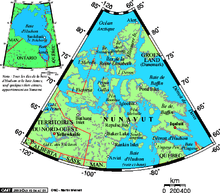Eureka Sound Formation
The Eureka Sound Formation is a geologic formation found in the Canadian Territory of Nunavut on Ellesmere Island, which is part of the Canadian Arctic Archipelago. The Eureka Sound Formation is Tertiary in age.[1]
| Eureka Sound Formation Stratigraphic range: Paleogene | |
|---|---|
| Type | Formation |
| Location | |
| Region | Nunavut |
| Country | Canada |

History
During the early Tertiary period, marine beds began forming in the Eureka Sound Formation within an area that was previously thought to be almost exclusively non-marine.[1] This discovery indicates that this region of the Arctic had been mild, temperate, and ice-free during the early to middle Eocene , despite being well above the Arctic Circle. As of May 2014, this discovery had been restricted to the easternmost regions of the Canadian Arctic on Ellesmere Island.[2] Because the Eureka Sound Formation contains the largest accumulation of Arctic Paleogene deposits, studying its marine deposits is key in gaining a better understanding of the early Tertiary history of the Arctic Ocean.[1]
Fossils
Some fossils discovered in the Eureka Sound Formation were Paleogene land vertebrates that include fish, turtles, and several types of mammals.[3] Other types of fossils found were reptilian species and several types of birds.[4] Fresh water molluscs were also found.[5]
Sediments and Geology
On Southern Ellesmere Island, the Eureka Sound Formation is up to 480 meters thick and consists of a sequence of predominantly non-marine sandstones, mudstones, coal and minor siltstones. Sandstone petrography and heavy mineral analyses indicate that the Eureka Sound sediments were derived mainly from Precambrian granulite-grade metamorphic rocks of the Canadian Shield located to the southeast of the Formation.[6] Another finding states that significant amounts of the rocks of the Eureka Sound Formation on Western Ellesmere Island are marine in origin.[5]
References
- "Circular, Volumes 905-917". 1984.
- "First Record of Eocene Bony Fishes and Crocodyliforms from Canada's Western Arctic".
- Dawson, Mary R.; West, Robert M.; Langston, Wann; Hutchison, J. Howard (May 21, 1976). "Paleogene Terrestrial Vertebrates: Northernmost Occurrence, Ellesmere Island, Canada". Science. 192 (4241): 781–782. Bibcode:1976Sci...192..781D. doi:10.1126/science.192.4241.781. ISSN 0036-8075. PMID 17777182.
- Estes, Richard (1980). "Eocene lower vertebrates from Ellesmere Island, Canadian Arctic Archipelago". Palaeogeography, Palaeoclimatology, Palaeoecology. 30: 325–347. Bibcode:1980PPP....30..325E. doi:10.1016/0031-0182(80)90064-4.
- West, Robert M.; Dawson, Mary R.; Hutchison, J. Howard; Ramaekers, Paul (1975). "Paleontologic Evidence of Marine Sediments in the Eureka Sound Formation of Ellesmere Island, Arctic Archipelago, N.W.T., Canada". Canadian Journal of Earth Sciences. 12 (4): 574–579. Bibcode:1975CaJES..12..574W. doi:10.1139/e75-051.
- "AAPG Datapages/Archives: The Eureka Sound Formation, Southern Ellesmere Island". archives.datapages.com. Retrieved 2015-05-07.
- Various Contributors to the Paleobiology Database. "Fossilworks: Gateway to the Paleobiology Database". Archived from the original on 31 July 2014. Retrieved 8 July 2014.